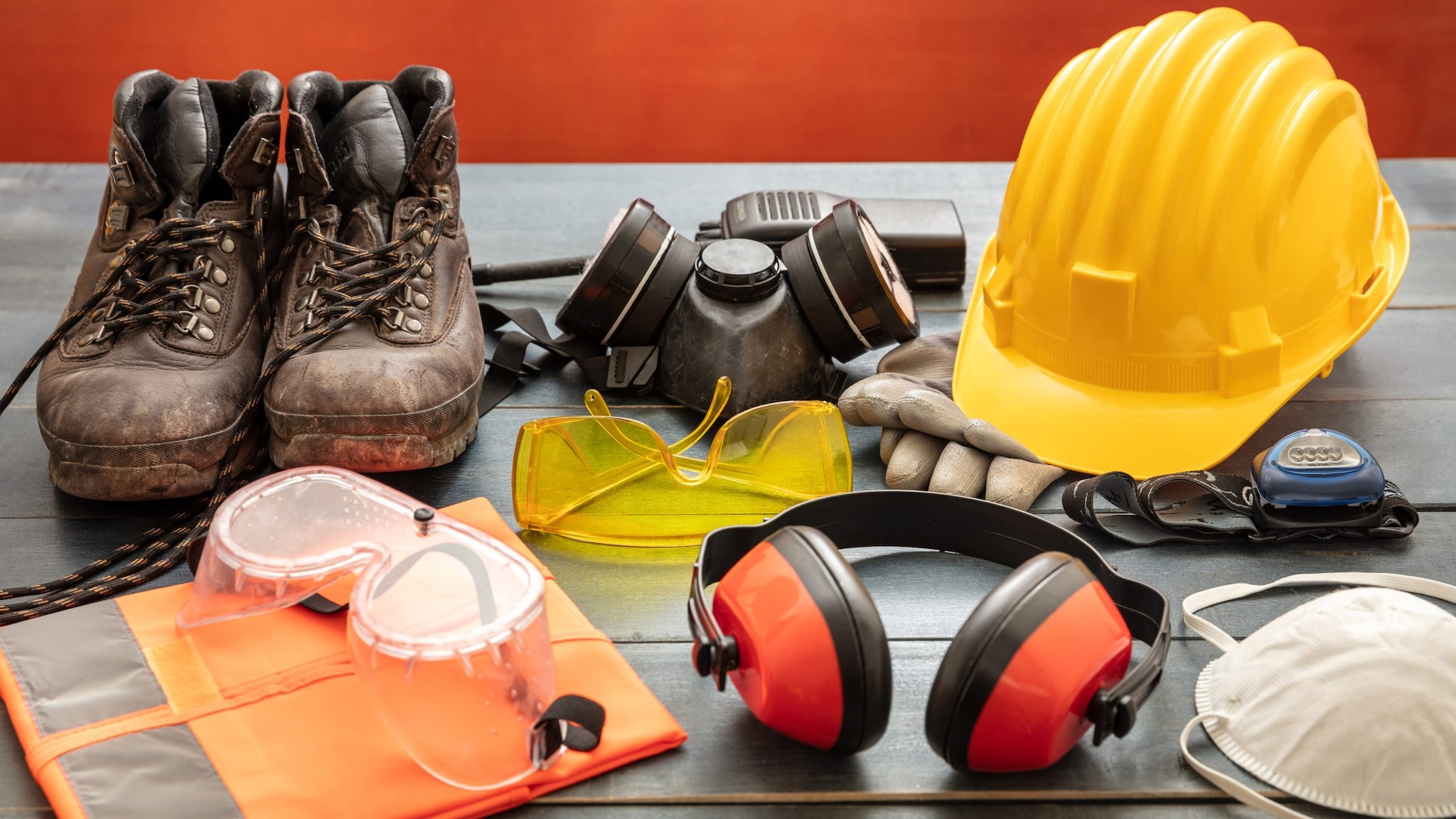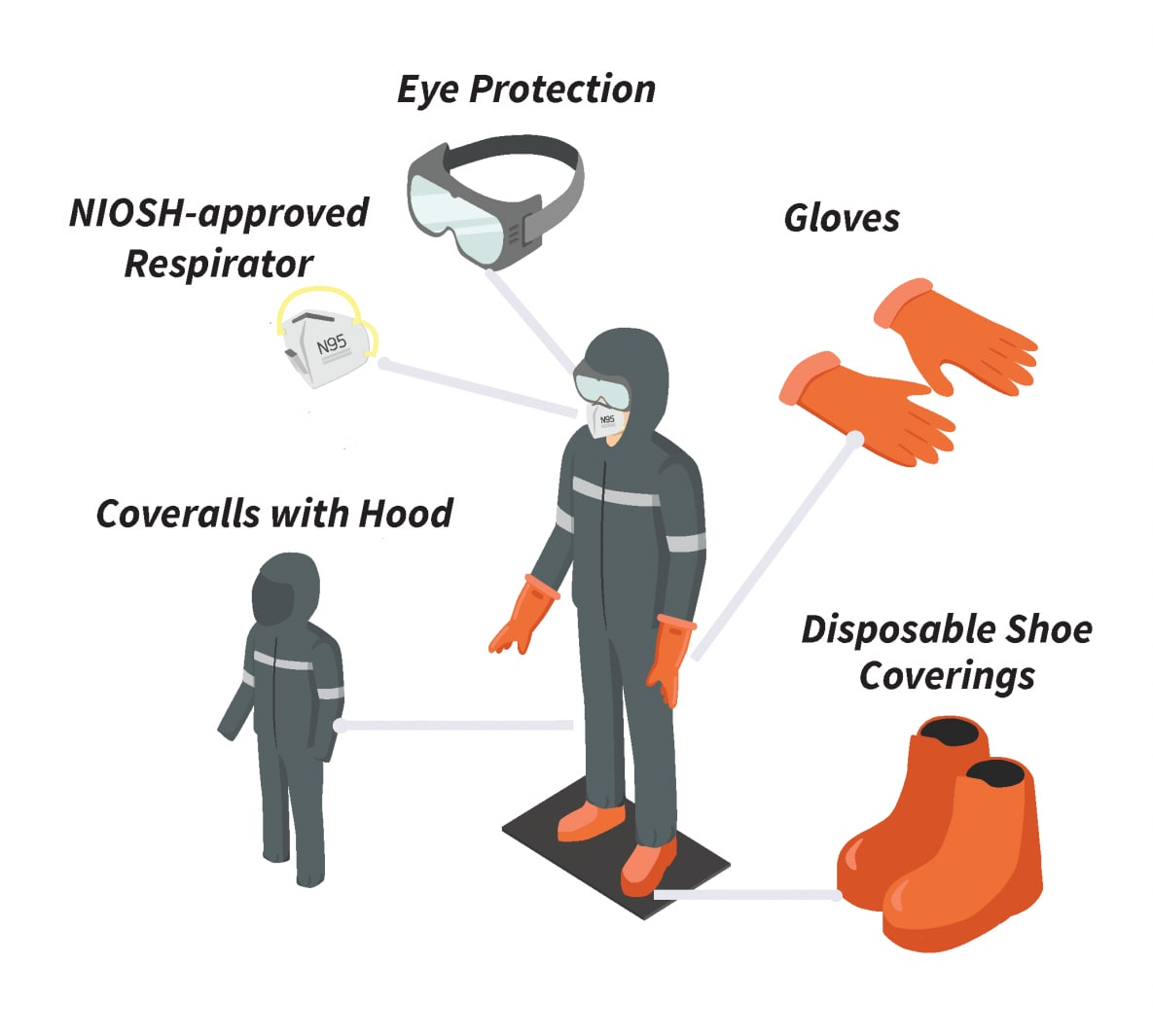At a glance
Use the hierarchy of controls to prioritize control solutions to occupational hazards. In addition to elimination, engineering, and administrative controls, personal protective equipment (PPE) including respirators can protect workers from Histoplasma.

Respiratory protection
There are no occupational exposure limits for Histoplasma. Respirators are designed to reduce the concentrations of dust and harmful airborne pathogens in the wearer's breathing air. Respirators are generally divided into two main categories:
- Air-purifying respirators
- Atmosphere-supplying respirators
Air-purifying respirators filter contaminated air. Atmosphere-supplying respirators provide an alternative supply of breathable air.
Workers needing protection against Histoplasma should use particulate-filtering air-purifying respirators. These include:
- Filtering facepiece respirators (e.g., N95)
- Elastomeric respirators (half facepiece or full facepiece)
- Powered air-purifying respirators (PAPRs) (tight and loose fitting)
Respirators must be NIOSH-approved and properly selected and used. Workers should immediately move to a non-contaminated area and replace the filter or respirator if:
- The filters become damaged or
- The respirator becomes difficult to breathe through or
- In the case of a PAPR, the airflow falls below the minimum level
Failure to do so might defeat the protective role of the respirator.
Research is limited on the effectiveness of respirators in protecting workers from breathing in dust and Histoplasma. However, respirators are expected to offer some level of protection. This is because the diameter of Histoplasma spores ranges from 1 µm to 5µm.123 NIOSH-approved respirators will collect all types of workplace aerosols, including airborne infectious organisms with very high efficiency.
Selecting respiratory protection
Respirators must be selected based on:
- The level of risk for histoplasmosis while performing the job
- The required assigned protection factorA to reach an acceptable risk level
- The advantages and disadvantages of each respirator class
Where Histoplasma is common
Medium-risk activities
Consider use of half-facepiece respirators, including filtering facepiece respirators, during medium-risk activities.
Medium-risk activities include:
- Working outdoors involving soil or plant matter disruption
- Demolition, excavation, or farming
- Working with live poultry or other birds
Note that working with live poultry or other birds becomes higher risks where large accumulations of droppings exist.
High-risk activities
For high-risk activities, consider using:
- A loose- or tight-fitting PAPR with any of the approved filters
- A full facepiece with 100 series filters
Wear these before and throughout high-risk activities. Approved filters for loose- or tight-fitting PAPR include HE, PAPR100-N, and PAPR100-P.
High-risk activities include:
- Remediating sites with documented Histoplasma
- Remediating sites linked to human illnesses
- Disrupting or cleaning up large accumulations of bird or bat droppings
- Removing trees or other plant material at large bird roosting sites
- Entering caves or tunnels where one might disrupt bat droppings
If PAPRs and full facepiece respirators with 100 series filters are not available, consider using filtering facepiece respirators. It should be noted that filtering facepiece respirators only have an assigned protection factor of 10. They only provide 20% of the protection afforded by PAPRs (APF 25–50) and full facepiece APRs (APF 50). A filtering facepiece respirator will provide some protection. The respiratory protection program manager will need to determine whether this is enough protection depending upon the wearer's environment.
OSHA respiratory protection programs
OSHA requires employers to develop and implement a written respiratory protection program. It should include required worksite-specific procedures and elements for required respirator use (29 CFR 1910.134). The program establishes that the employee required to wear a respirator must be:
- Trained,
- Medically evaluated, and
- Fit tested.
Cleaning, disinfecting, and properly storing a respirator are also important to guarantee they protect the wearer properly.
More information
Other recommended PPE
Gloves should be worn when removing large amounts of droppings or when a person's hands will touch contaminated soil or other material. Disposable gloves (vinyl, nitrile, PVC, or polyethylene) should be worn under regular cotton or leather work gloves. The use of eye protection (either eyecup or cover-type safety goggles) is recommended, especially when working in ventilated worksites.

Disposable protective clothing and shoe or boot coverings should be worn whenever regular work clothing and shoes might be contaminated with Histoplasma spores. This can reduce or eliminate the likelihood of transferring spores to places away from a work site, like a car or home.
When spore-contaminated material is likely to fall from overhead, workers should wear disposable protective clothing (coveralls) with hoods. Workers should wear disposable shoe coverings with ridged soles made of slip-resistant material to reduce the likelihood of slipping on wet or dusty surfaces. Since protective clothing can be more insulating than regular work clothing, precautions may be necessary to control heat stress. After completing work, workers should remove all protective clothing and shoe coverings and seal them in heavy duty plastic bags for disposal.
- APF: the level of workplace protection that each class of respirators is expected to provide to employees when the employer implements a continuing, effective respiratory protection program. OSHA assigned protection factors are found in Table 1 of the OSHA Respiratory Protection Standard.
- Deepe GS Jr. [2000]. Chapter 254: Histoplasma capsulatum. In: Mandell GL, Bennett JE, Dolin R, eds. Principles and practices of infectious diseases. 5th ed. Philadelphia, PA: Churchill Livingstone, pp. 2718–2733.
- Cano MVC, Hajjeh RA [2001]. The epidemiology of histoplasmosis: a review. Semin. Respir. Infect. 16(2):109–118.
- Wheat LJ [2000]. Chapter 3: Histoplasmosis. In: Sarosi GA, Davies SF, eds. Fungal Diseases of the Lung. 3rd ed. Philadelphia, PA: Lippincott Williams and Wilkins, pp. 31–46.
- Storch G, Burford JG, George RB, Kaufman L, Ajello L [1980]. Acute histoplasmosis. Description of an outbreak in northern Louisiana. Chest 77:38–42.
- Leslie L, Arnette C, Sikder A, Adams J, Holbrook C, Bond J, King B, Roberts K, Patrick MS, Palmer C, Finger R, Tomford JW, Rushton T [1995]. Histoplasmosis— Kentucky, 1995. MMWR 44(38):701–703.
- Lenhart SW [1994]. Recommendations for protecting workers from Histoplasma capsulatum exposure during bat guano removal from a church's attic. Appl Occup Environ Hyg 9:230–236.
- USAEHA [1992]. Managing health hazards associated with bird and bat excrement. Aberdeen Proving Ground, MD: U. S. Army Environmental Hygiene Agency, U. S.Army Environmental Hygiene Agency Technical Guide 142.
